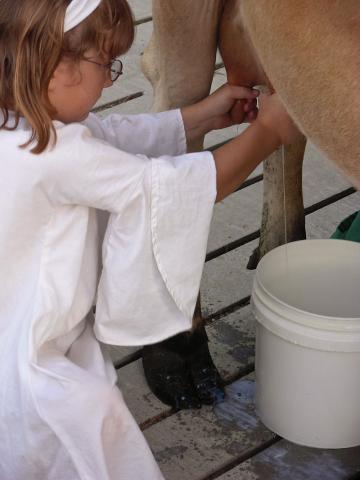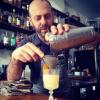
A few weeks ago, a friend mailed a box of old recipes to me because he knows I’m interested in such things. In amongst the mid 1980’s newspaper sections of Christmas cookies and odd advertisements was a column from the Dallas Times Herald that collected famous people’s holiday recipes – things like Ed McMahon’s turkey and brandied stuffing (the less said about that the better), but the jewel of the collection was a recipe from Charles Dickens’ great granddaughter for “Lemon Milk Punch”. This must have greatly confused 1980’s Dallasites. The recipe is in the Kindred Cocktails database now, but it was also a starting place for some interesting thoughts about milk clarification.
Originally, the addition of milk to a punch base was a way to “soften” the drink for the stomachs of delicate drinkers. Though this technique started in the mid 18th century, the process of fining wine is about as old as winemaking itself. Winemakers knew that if a substance like milk or blood was added to a barrel of wine, changes to the clarity of the wine would occur and with them, rough edges would be smoothed away and the stability of the finished product would be enhanced.
This smoothing and preservation was important before the 20th century. After Dickens died in 1870, bottled milk punch was found in his cellar still pleasant to drink. But in the hundred years or so between his death and the publication of his punch recipe, milk clarification fell out of favor. Modern food purity laws in the United States (among them the Bottled in Bond Act of 1897) and a better understanding of distilling and aging of spirits mean that there aren’t a lot of rough edges to be smoothed away. Modern refrigeration means that the fight against spoilage isn’t a matter of guesswork anymore.
Charles Dickens Lemon Milk Punch
Dissolve the sugar in the first measure of water. Pour everything except the lemon juice and the milk into a large nonreactive container. Cover and let steep for 6 hours. Add the lemon juice and milk, mix well, then strain through cheesecloth until clear.
But here’s the thing. Clarifying punch with milk is commonplace – Camper English has done some great work here – a lot of people leave it at that. But the techniques involved can be used to great effect in the clarification of cocktails. Not to preserve them or soften harsh spirits, but to peek under the hood at the hidden flavors of amari or break longstanding rules… anyone up for a lime oleo-saccharum?
Since this is a technique more than a list of recipes, it’s important to look at each component – the milk, the acid, and a clarification set up to see how it actually works. But this is pretty simple, and once the tinkering begins, just about anything can be clarified with milk and the results are fascinating.
Milk looks simple but it’s really incredibly complex. It’s about 88% water and 12% solids. Of those solids, about 4% is fat and the remainder is other things, including 5% lactose, 3% proteins and 1% minerals. Most of the 3% that is proteins is casein… this is the important stuff. Keep in mind here that lactose is only about 20% as sweet as table sugar – it really has no effect on the sweetness of the finished drink. To put it in simple terms, you’d need 50 ounces of milk to equal the sweetness of one ounce of 1:1 simple syrup.
There are three phases in milk – the liquid phase, which is water, minerals, some enzymes and lactose, the colloidal phase, which is casein, some minerals, and other proteins, and there’s the fat phase, which is an emulsion with particle sizes that are homogenized to a size so small they can’t clump together and rise to the top of the milk as cream.
While we’ll be dealing with the results of the liquid phase in our finished drinks, it’s the colloidal phase that is interesting to us. Casein molecules are hydrophobic, so they form clumps in the milk called micelles which are smaller than the fat particles. One variant, known as kappa casein caps the ends of the molecules and is negatively charged at the 6.6 pH of milk so they repel each other. But drop the pH to 4.6 and kappa casein becomes neutral and the micelles clump together. Suddenly, your milk looks grainy and unappetizing. It is curdled.
So what to do with grainy clumps of milk in a watery substance? Those protein clumps are great filters for bitterness and color. All that’s necessary is to get the milk to a 4.6 pH – this can be done with any acid, and while it’s doesn’t take a lot of milk to clarify a drink or a lot of acid to curdle milk, it’s important to take a quick look at the readily available acids and choose the best ones for the job:
| Acid | pH (typically) | Notes |
|---|---|---|
| Citrus juice | 2.3 (lemon) 2.4 (lime), 4.3 (orange) | Basic fruit flavors |
| Tartaric | 2.2 | Fairly neutral |
| Citric | 2.2 | Zingy, lemony |
| Lactic | 2.4 | neutral |
| Phosphoric | 2-2.2 | Fizzy in a weird way |
| Acetic (vinegar) | 2.4 (white) 4 (balsamic) | Sharp aromas, careful! |
| Malic | 2.2 | Granny Smith apples |
Now let’s look at the technique, then look at a specific example I made last night. I use a Chemex setup to make coffee in the mornings – the carafe is glass and holds about a liter and the filters are fairly heavy. If the cocktail I’m clarifying contains an acid, I will measure out warm whole milk in a medium sized pitcher to 25% of the volume of the drink. Add whatever acid component there is to the milk, stir a bit and wait a few minutes for the curdling to take place. Then you can build the remainder of the cocktail in the pitcher, stir a little, wait a few minutes, then pour it slowly through the damp Chemex filter into the carafe. I usually double the volumes to make two drinks. Stick the whole Chemex setup in the refrigerator overnight and in the morning, pour off the liquid into a labelled jar.
If the cocktail doesn’t contain citrus it’s just about as simple. Curdle the milk with something neutral – cream of tartar or Lactart work well here, pour the milk through the Chemex filter (remember to form a layer of curds up the side of the filter – this is where clarification happens), then pour the cocktail through the curds, refrigerate, and wait. In the morning, pour off the cocktail in the carafe into a labelled jar. The important thing here is that the liquid dripping from the filter should be clear – if it’s milky, you don’t have curdled milk, so pour the drink back into the pitcher, add a pinch of neutral acid like tartaric and stir and wait again for curdling.
Now you might be thinking – why 25% of the volume as milk when so little milk is needed to clarify a drink? This technique uses the whey fraction of the milk as a dilutant so there’s no need to shake any drink clarified in this fashion over ice.
Sauternes Corretto
Acidify the muddled pineapple with the tartaric acid, add the remaining liquors, wait 5 minutes, strain into the milk, stir and let sit 5 minutes to curdle. Strain through a damp Chemex filter into a carafe - it's best to do this in the refrigerator overnight. Transfer to a jar and label.
My first foray into using this system was an attempt to make a cocktail that tasted like a glass of Sauternes using Amaro Sibilla as the “honeyed” notes. Now Sibilla isn’t the scariest amaro I have in the bar, but it’s up there. The gin mimics the Sauvignon Blanc component and the apricot and pineapple are very common (and delicious) flavors. But it ends up tasting like Jamaican rum and coffeed notes from the Sibilla.
Last night, I clarified a double batch of a slightly modifued version of Maks Pazuniak’s Red Hook Burning, which came in at 7 ounces of cocktail. I had a blood orange (the bitters in the drink made me think of this), so I juiced and strained a quarter of it to get an ounce and added a pinch of citric acid. This juice went into 1.5 ounces of warm whole milk and it curdled. I dripped the milk into a damp Chemex filter, let it filter for a few minutes, then added the rest of the drink. The next day, I poured off about 8 ounces of tawny-orange cocktail which had heavy citrus overtones and a lot of leathery midpalate, but very little Campari bitterness. It affords a peek at the undertones of Campari which are really rather pretty and the texture is suave and silky. I think this homage needs a new name, so I’m calling it Sparks and Gledes.
For an encore, I thought I’d break one of the cardinal rules of punch making: never ever make a lime oleo-saccharum. “It’s too bitter!” they say, well they were wrong about me and they’re wrong about lime oleo-saccharum!. Well, the milk in the Dry Float Punch tames the bitterness of the lime oils and softens a drink that too often relies on sugar to balance a whopping 2.5 ounces of lime juice per drink. But using a lime oleo-saccharum for the aromatics then removing the bitterness with milk means this drink is tart and savory with a mere ¾ ounce of lime juice.
The main goal of this technique is to remove bitterness, so obviously amaro-heavy drinks are a prime target for clarification. Milk clarification also does remove wood aged flavors and colors from spirits, so be cautious using long aged brown spirits. I have found it preserves acidity and damps down most flavors, making them somewhat homogenous, like adding a pat of butter to a red wine pan sauce smooths over the rough edges of wine and shallot.
With some curdled milk, just about any drink can be processed to show a new side. On my agenda, the Trinidad Sour, a drink with a Suze base that hopefully will end up smelling like a style of men’s cologne called a fougere, the Gunshop Fizz but swapping out Peychaud’s for Bitter Truth Creole bitters, and just about anything else I can think of. Milk clarified cocktails have gorgeous colors, intriguing textures, and allow the intrepid mixer to see a hidden world in familiar spirits. With a technique that’s easy to learn and a little patience, it’s simple to produce some fascinating drinks.
Interesting wording here. I'd always thought that in "clarified milk punch" the "clarified" modifies "milk" not "punch"--that is, that the milk was what was being clarified, not what was doing the clarifying. Your way of using the word opens my attention to how the milk affects the other ingredients.
Craig - it's both actually. The milk is "clarified" with the change in pH (whey is clear but the suspended fats and casein proteins make milk opaque) but once the casein proteins and fats are out of solution, they can do the heavy lifting of clarifying the rest of the drink. Thanks, Zachary
The old milk punches were rather sweet. There was so much sugar and enough alcohol that it was stable like a liqueur. Tough to drink more than a ounces, but it required no refrigeration. Today's cocktail-based milk punches don't have enough sugar to preserve things at room temperature, so refrigeration is necessary but they're so easy to drink on their own without over-sugaring the palate.
Hi Fred - after reading your comment, I did some searching and found this: https://www.masshist.org/database/viewer.php?item_id=263&mode=large&img_step=1& - it's a 1763 recipe for Milk Punch from Benjamin Franklin. It's 15 quarts of liquid (60 cups) and 2 lbs of sugar, which if it's white(ish), is 4.5 cups. Even assuming a 10% volume loss from the milk, that's still 58 cups of liquid. This doesn't seem very sweet, but it may be more of a punch than a drink to preserve. Thanks, Zachary
Look for recipes that say Punch Name (For Bottling). The California Milk Punch (for bottling) in Jerry Thomas' first book has a 1/2 pound of sugar to the juice of 4 lemons (lemons were tiny back then and not the 1+ oz guys we get today) plus whatever acid quotient pineapple brings. Given Kindred Cocktails' aversion to anything sweet (I read the negative feedback on drinks I have posted), this would garner a 2 star drink. However, the palate for drinking back then was sweet (even champagne was really sweet).
That Franklin recipe does say to "bottle it off" but I suppose that doesn't mean "preserve". Assuming it was 90 proof spirit, that's only 4% alcohol in the finished drink, so not enough booze or sugar to do anything. Thanks, Zachary
I hadn't seen the method of creating the strained curds and then pouring the cocktail through it - I typically add everything together and then pour through a filter twice after letting it sit. Is there an advantage to doing it this way?
Thank you for the read. Found it wonderful, and instantly signed up for future work.
Years ago I had a recipe for "portuguese milk punch" that I attempted in orange and lemon variants. The result was a clear, tinted liqueur, with a bright but smooth and creamy citrusy flavor. I'm going to have to dig this up and try again!





Wow! New Horizons!